Update 2 from the studio
Restoration of 'The Reixach'
March 2022
There is news from the studio where our "enthroned Madonna and Child" by Joan Reixach is being restored. Work has been hard and we are happy to share the latest findings and news. Scroll on quickly and find out what the studio has found.
The varnish removal
At this time, all varnish has been removed from the paint surface. Overpaints have also been taken off. These were particularly present along the seams in the panel. In general, the overpaintings were very broadly applied and covered much of the original material. A good example of this was seen at the top left of the scene. In the background, a rock formation is visible here. This rock formation had been made much larger than it originally was during a later restoration. This had been done by adding filler and overpainting to disguise the seam and a small damage in the gold. A historic photograph from around 1920 shows that this addition is not yet present.
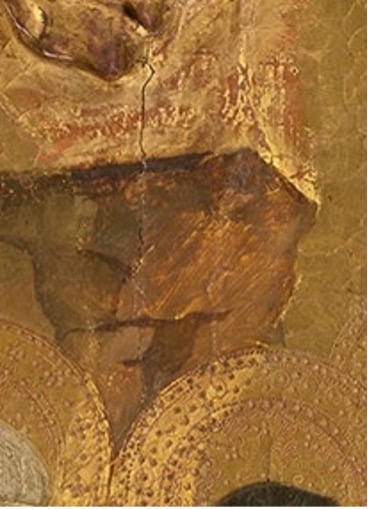
Background detail for treatment
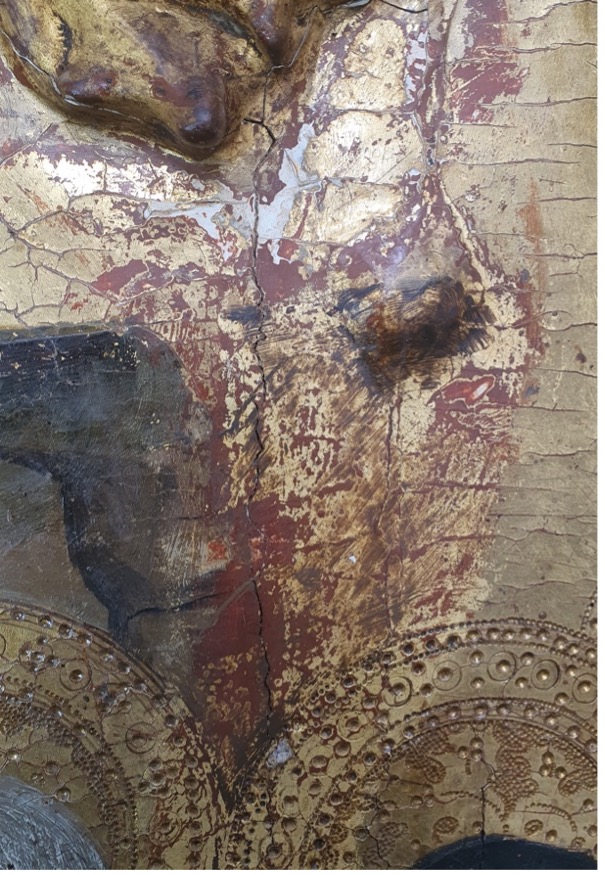
Background detail during treatment
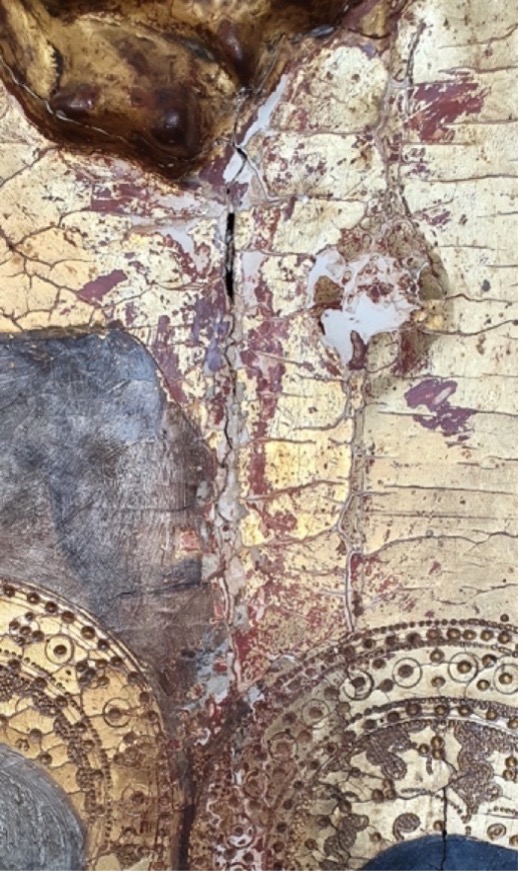
Background detail after treatment
Over-gilding moldings
While taking off the varnish, it became clear that an edge about 3 cm wide had been over-gilded along the carved moldings. This over-gilding was clearly recognizable by its different color and sheen. It was also clearly visible that the punching had been sealed by the application of this over-gilding. This was a clear indication that it was an over-gilding, as punching is applied after the gilding is applied. Gilding applied in the punched-in holes is therefore of later date.
Since the over-gilding followed the moldings so closely, the suspicion arose that the entire moldings had been over-gilded. It looked as if when they applied this gilding to the frame they had not been so meticulous and so had included the edges of the painting and flat gilded areas.
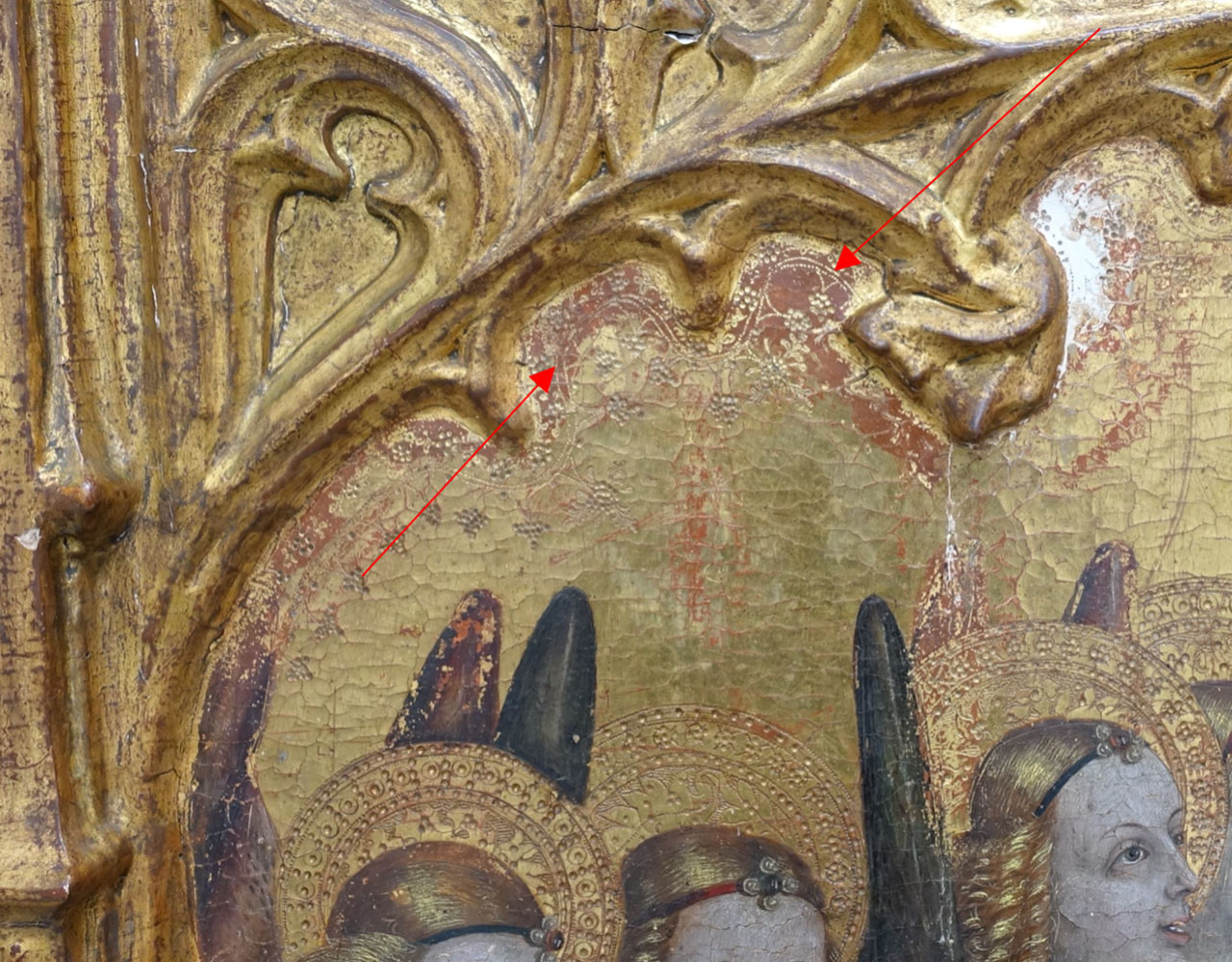
To investigate this assumption, paint samples were taken and embedded as cross sections. The samples were taken from the different parts of the moldings (both horizontal posts, both vertical rules and a deeper part in the decorative carving). In all the samples, except the sample from the lower rail, gold leaf was found under a layer of filler, bolus and new gold leaf.
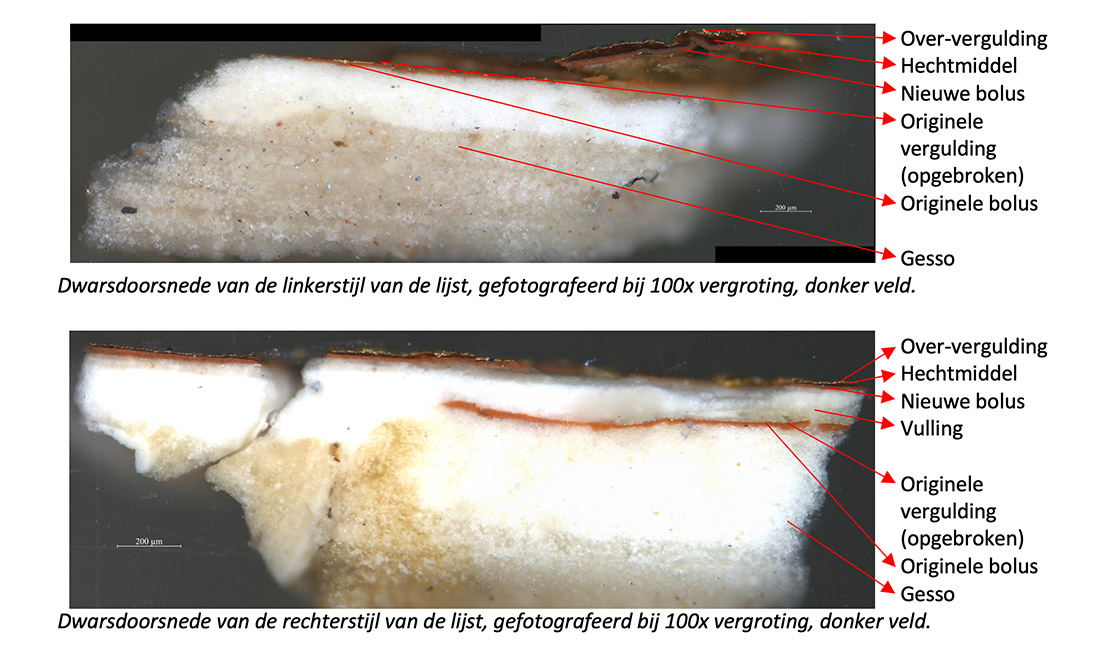
Only new gold leaf was found on the lower rail. This confirmed the suspicions that the lower rail was not original, but a later replacement. This could also be seen in the X-rays, where an anomalous wood texture was visible and modern screws used to secure the lower rail.
Examination of the paint samples confirmed that the entire frame has been over-gilded. Original gilding is still present under the new gilding in many samples, albeit fragmentary. Presumably, when the bottom rail was replaced, the entire frame was re-gilded to ensure that the bottom rail and frame would fit together properly.
Over-gilding moldings
All over-gilding on the flat areas of the gilded background was removed. This could be done relatively easily with water, or with a water-based gel. The underlying original gilding is locally damaged and contains small gaps, but overall the removal of the over-gilding has brought back much original material that is in good condition. The uniform, warm luster of the original gold is much nicer than the later gilding.
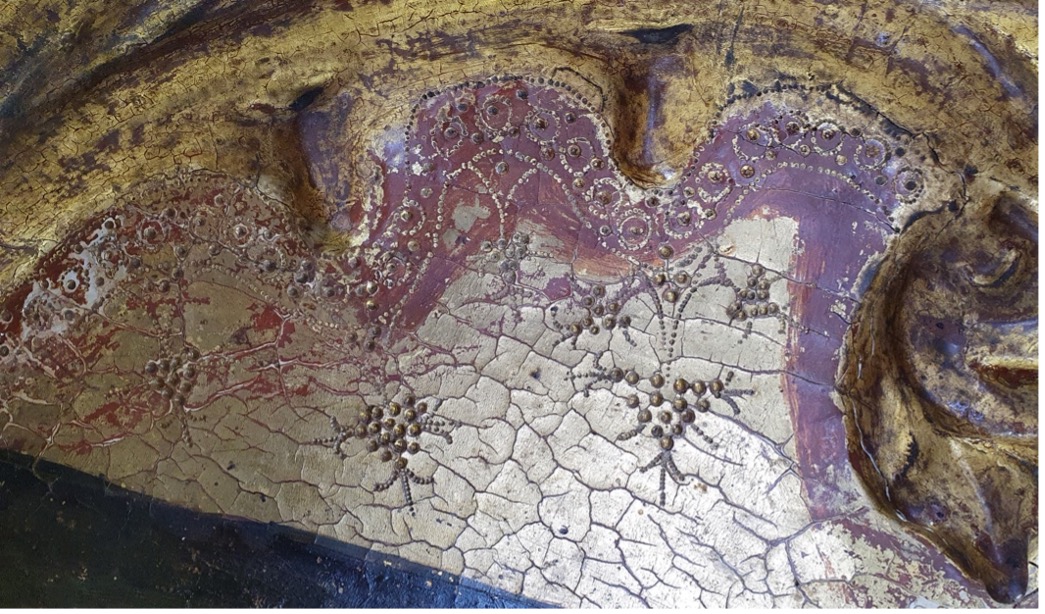
Detail overpainting along moldings for decrease
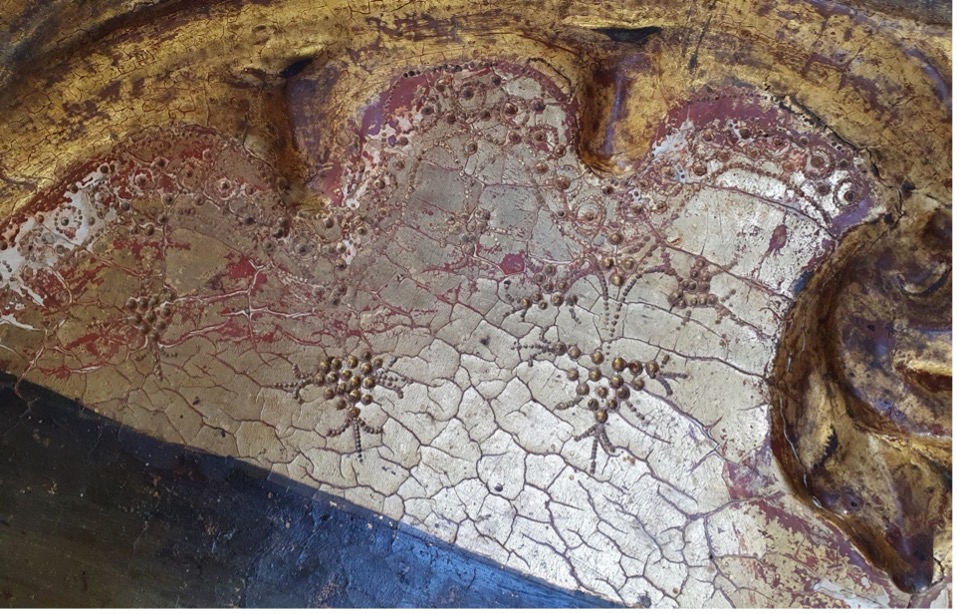
Detail after decrease repainting
To estimate the condition of the original gilding under all the later additions, test windows were made on the moldings. The result of these tests does not disappoint: throughout there is a reasonable amount of original gold present, which is in good condition. With the removal of the later over-gilding, the gilding of the background flows seamlessly into the gilding of the moldings. There is no longer a border or transition. Also, the color is much nicer; it is a lighter, warmer shade of gold.
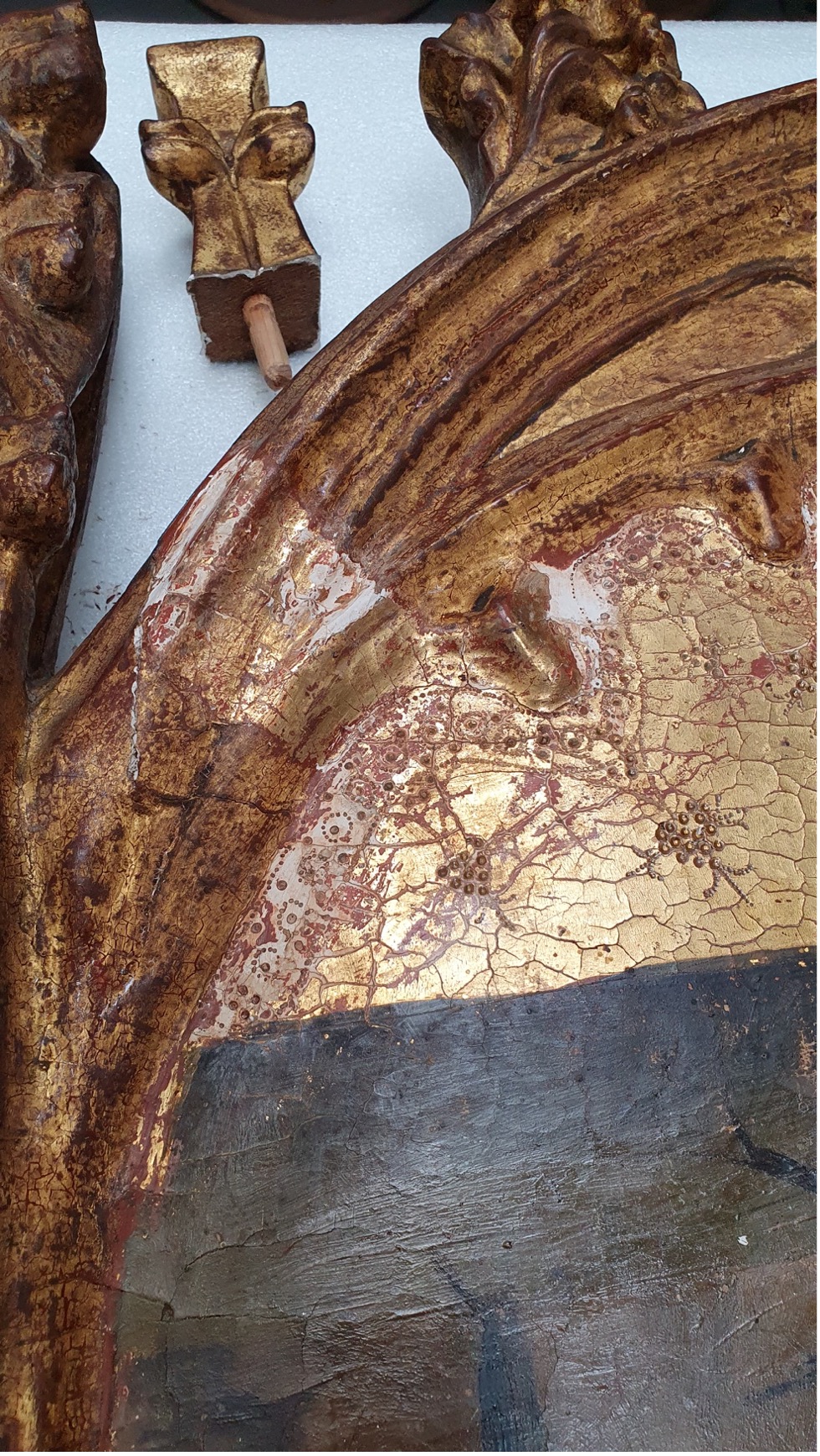
Test for decrease over-gilding moldings.
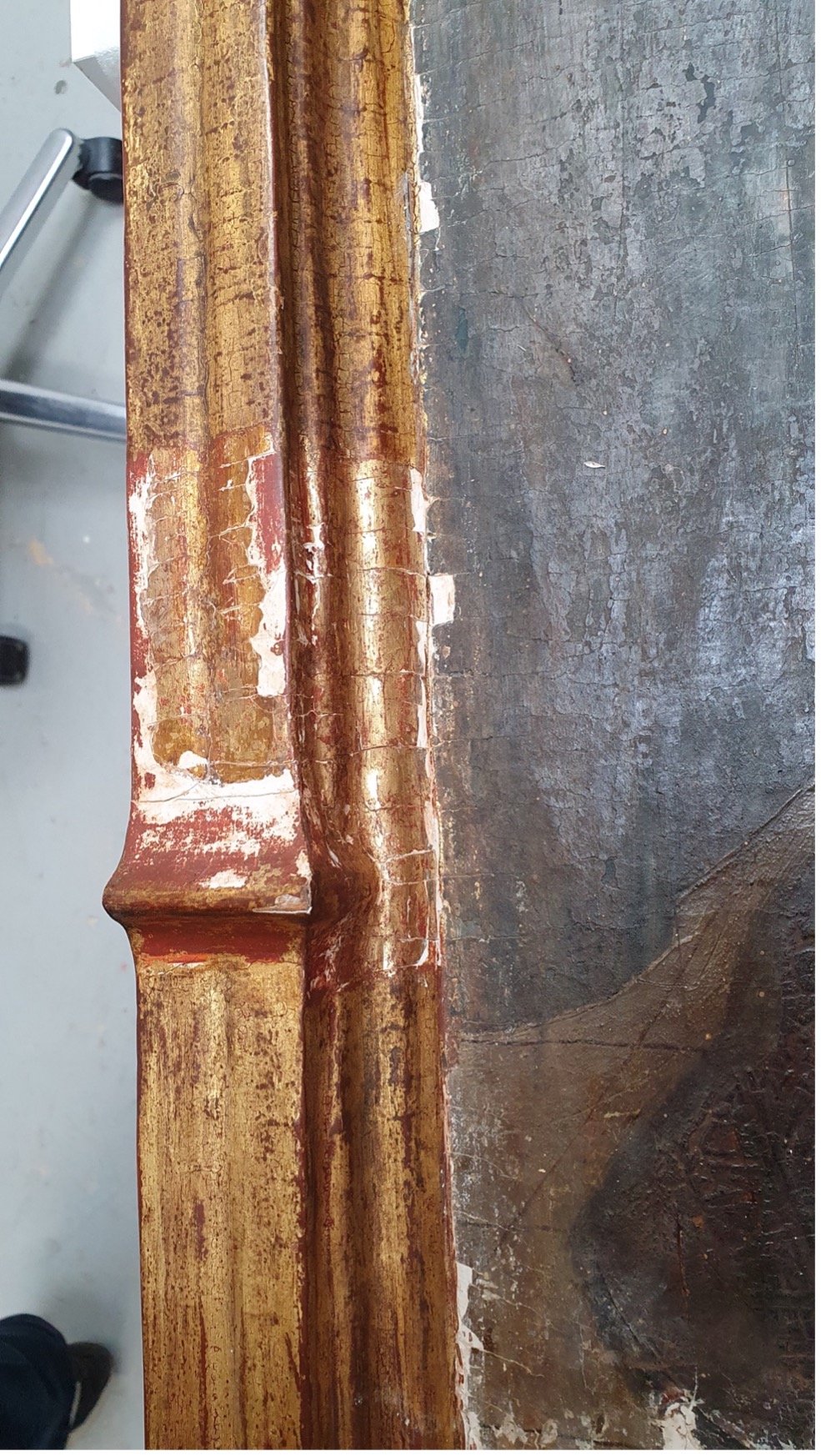
The white and red spots in the tests are gaps.
The tests have shown that it is possible to remove the over-gilding. The tests are also very hopeful for the condition of the original gilding under the moldings. In consultation with the committee, it was concluded that removing the over-gilding on the moldings would be the best treatment option. The added value of the original gilding to the appearance of the work is great. Framing and painting are originally one unit. The altered appearance of the frame by the over-gilding has changed this somewhat: the frame stands out from the original gilded surfaces. Removal of the over-gilding brings the entire object back into balance.
Gray haze
Beneath the varnish layer there is a grayish, grayish layer on the paint surface. This layer is thicker in some areas and more patchy in others. The layer shows no fluorescence under UV radiation and is not sensitive to solvents. To investigate this layer, 2 paint samples were taken and embedded as cross sections. This revealed that it is a very thin, semi-transparent layer that is particularly present in deeper areas in the paint surface.
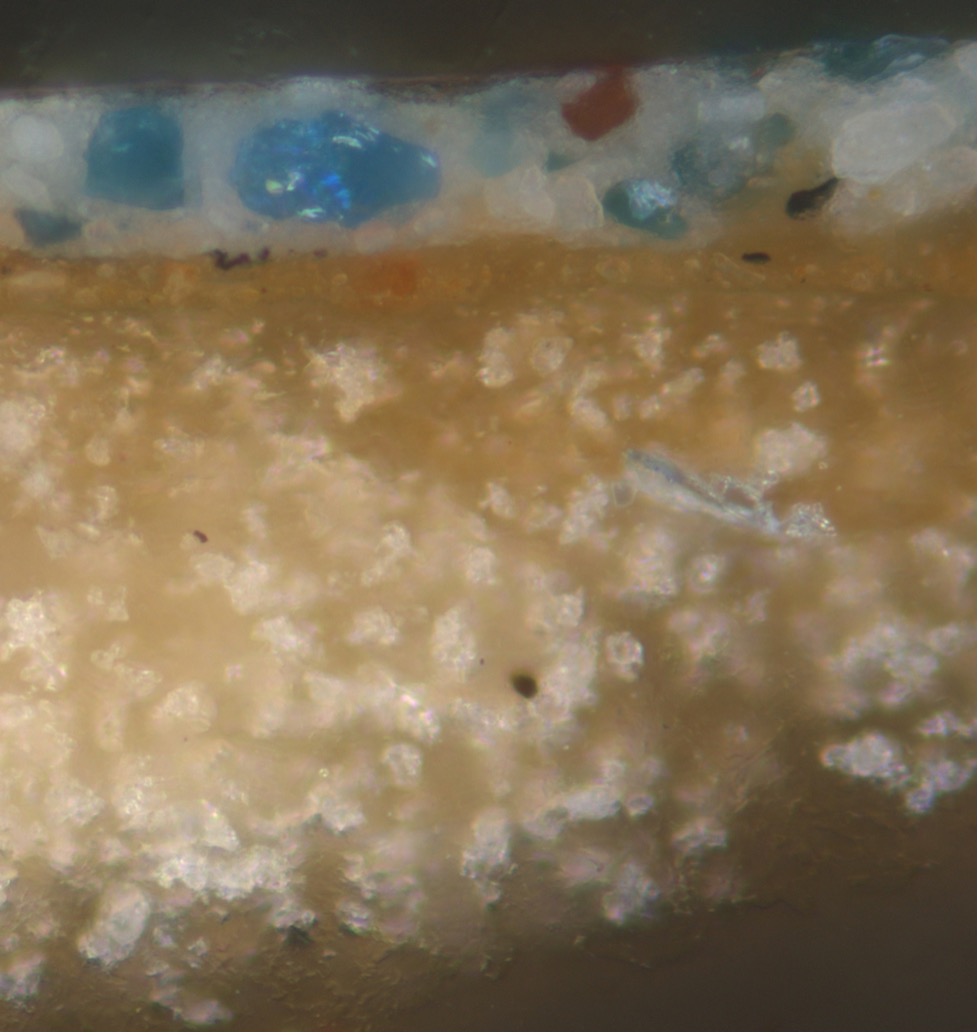
Detail from paint sample, 400x magnification, bright field.
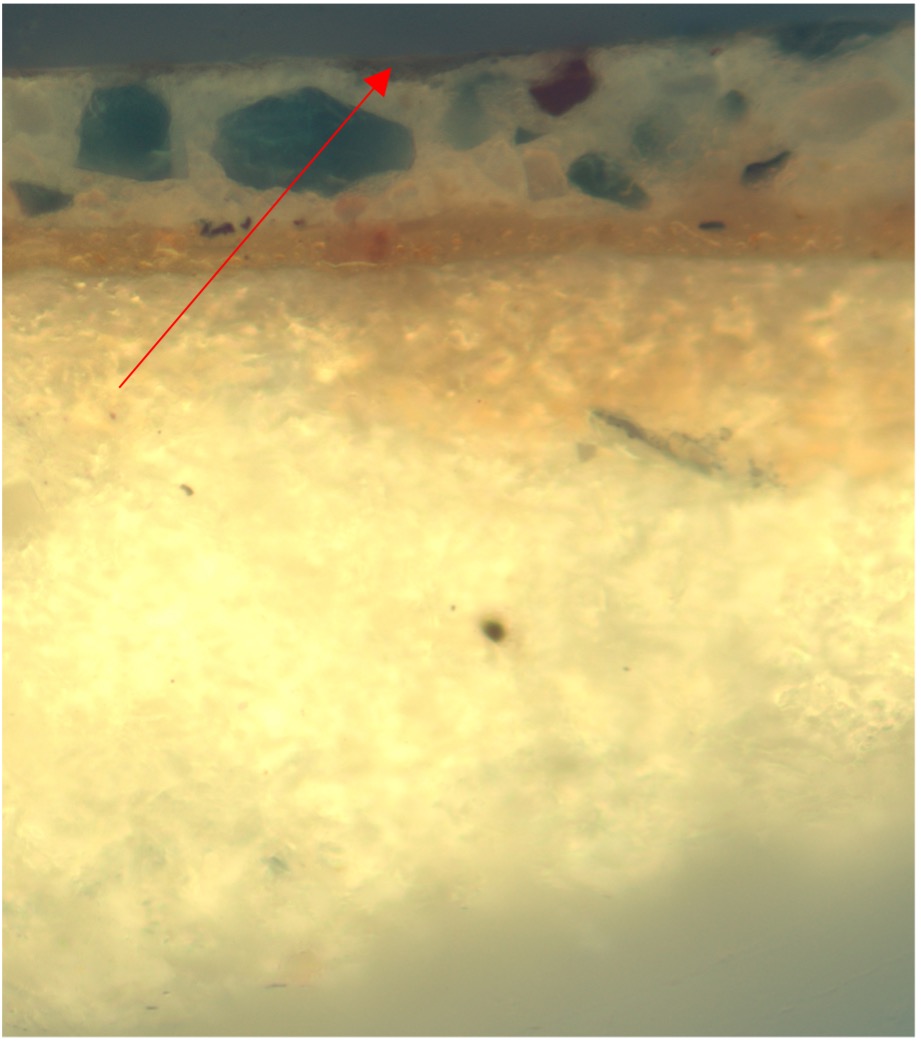
Detail from paint sample, 400x magnification, UV radiation
The paint samples were then examined at the RCE with SEM-EDX (by Dr. Ineke Joosten). From this examination it was concluded that it is an organic layer rich in Calcium and Oxygen. Two scraping samples were also taken and examined with FTIR (by Dr. Suzan de Groot). These showed that the material consists mainly of protein and chalk, with possible degradation products such as calcium oxalates in the layer.
After conducting these investigations, tests were done to remove this layer. The tests showed that the layer could be safely removed with an emulsion of Pemulen TR2 buffered at pH 6.5.
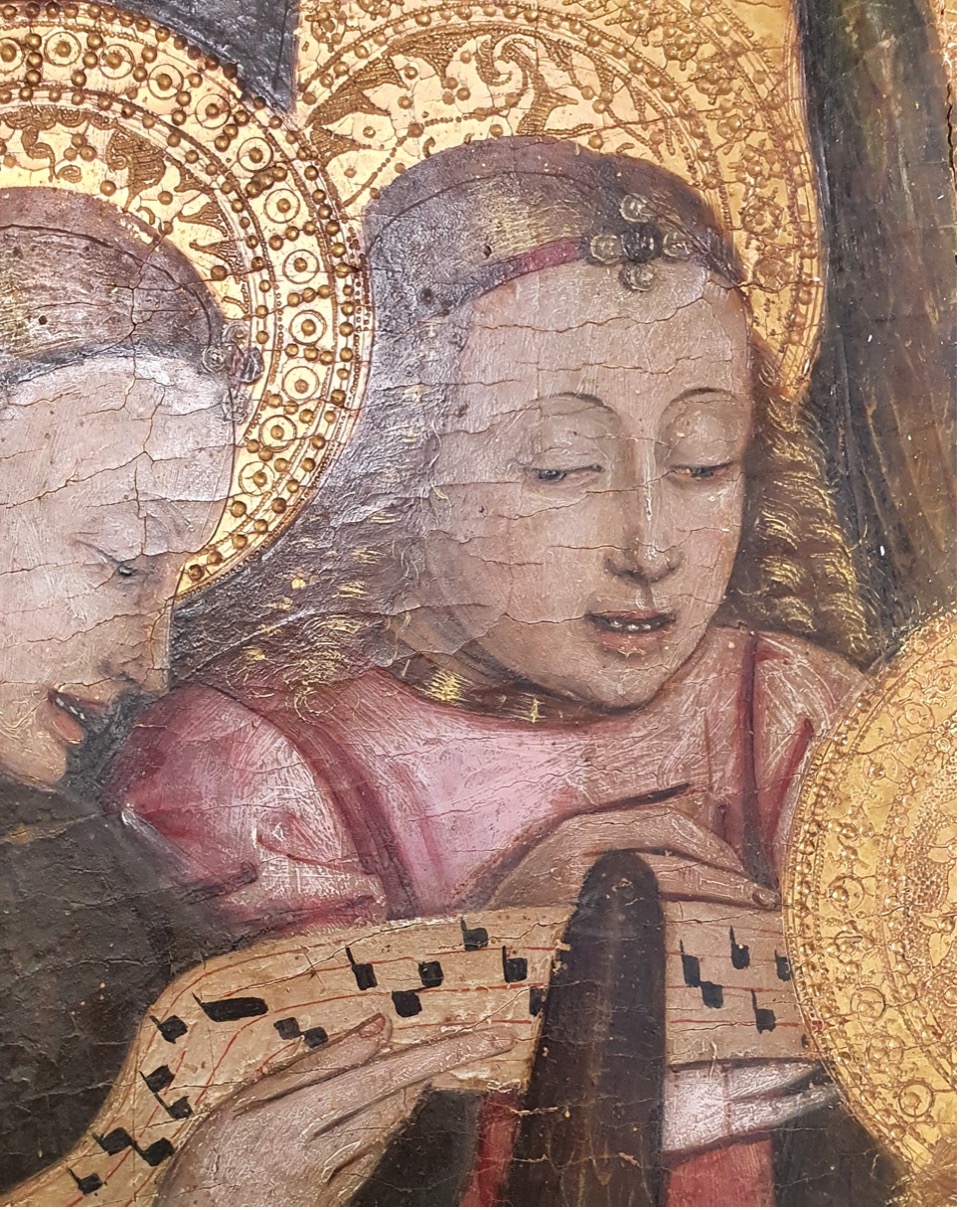
Test for decrease gray layer: the left side of the tunic is cleaned, the right side is not.
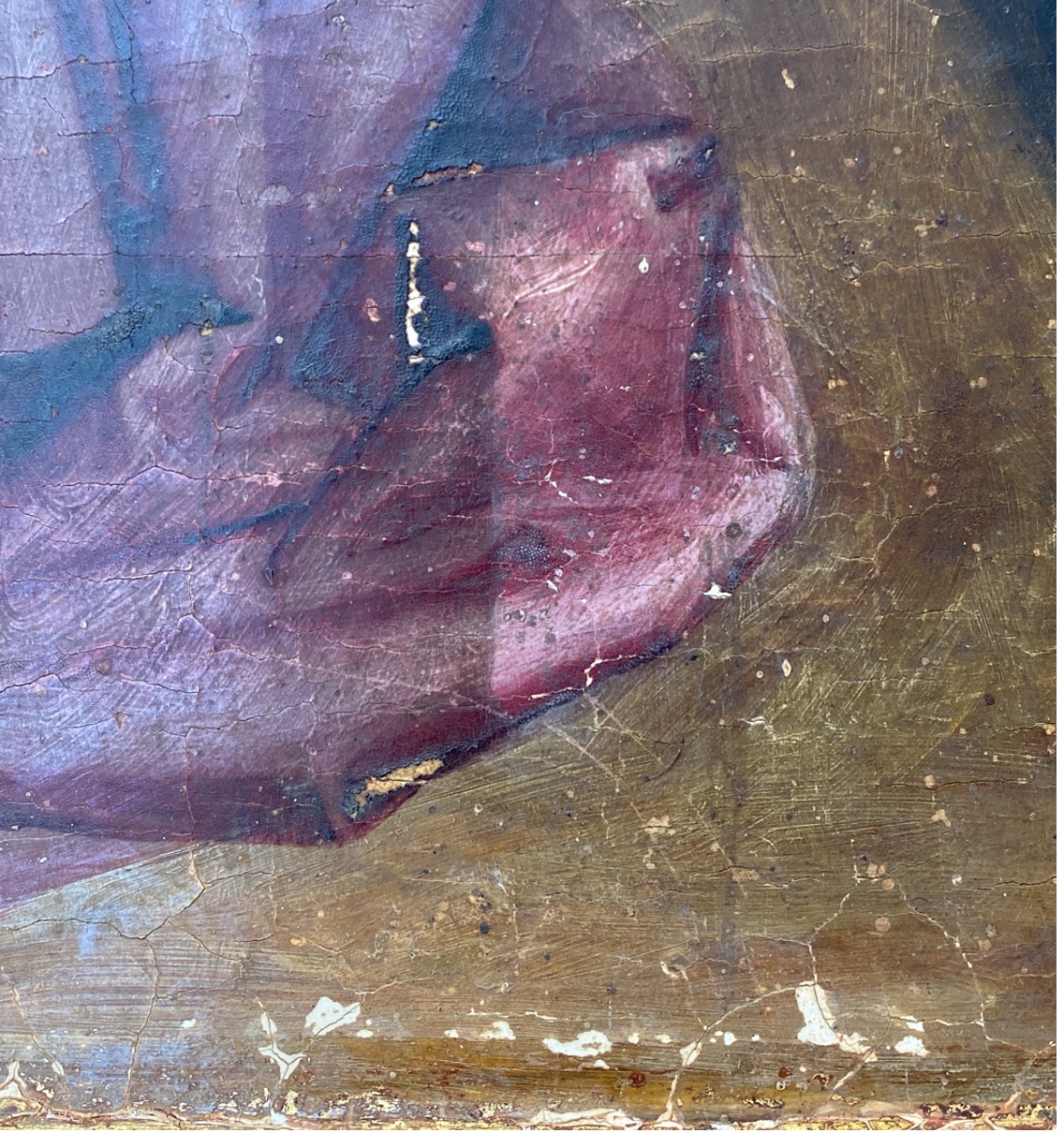
Test for decrease gray layer: under the dark gray layer a beautiful pink drape appears.
The tests for removing the gray layer are very promising: the surface lightens in color, the original color balance returns. The beautiful, deep colors used in the angels' clothing shine again. However, in consultation with the committee, it was decided to conduct further research on the gray layer before deciding to remove it. What exactly is it? Is it possibly an original layer? Previous investigations as described above indicated a protein varnish. Literature research shows that protein varnishes were common in artists' handbooks in the 18th and 19th centuries. It is possible that this protein varnish layer was applied during a later restoration. However, the earlier research did not provide a complete answer as to the composition of the layer. In fact, it is quite possible that the underlying paint layers are also bound in protein. Thus, if the scrapings were taken too deeply, material from the underlying layer could have been included. Thus, it is not entirely clear where the protein found came from. For this reason, it was decided to examine another cross section with FTIR. If this examination is done on a cross section, it can be visualized where exactly the protein is located, in the gray top layer or in the underlying paint layers.
Currently, more literature studies on the application of protein varnish are underway and awaiting the results of the FTIR study.
Restorers:
Melissa Daugherty MA, PD Res
Marya Albrecht MA, PD Res
Gert van Gerven MA
